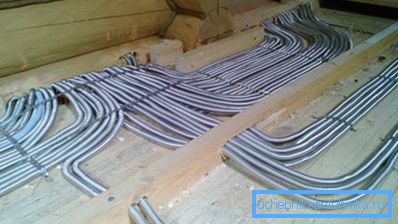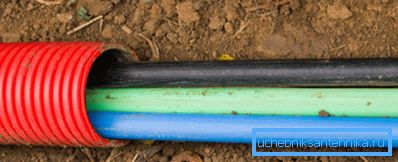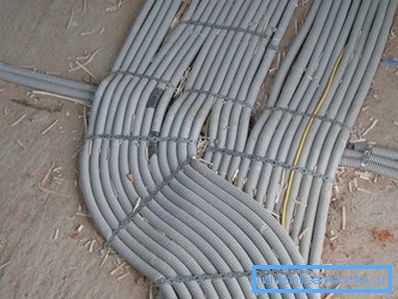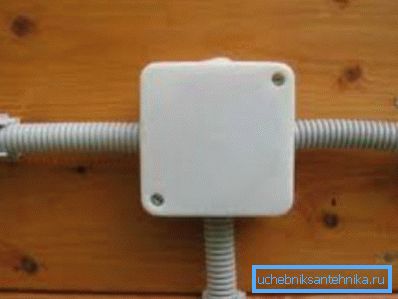How the cable is laid independently in pipes of various
If laying a cable in a pipe under a road is something quite ordinary, then a similar arrangement of power or low-current wiring in the thickness of the screed or in a wall has become widespread relatively recently. Previously, most compatriots laid the power cable in the pre-made grooves, but the use of the pipe shows a number of obvious advantages.

Advantages of laying cable in the pipeline

A pipe for laying a cable in the ground, on a screed or in a wall, in comparison with gates, is characterized by such advantages as:
- long operational resource of conducting;
- the possibility of simple and effective maintenance and repair work without the need to destroy the walls or screed;
- the possibility of economical installation of electrical wiring;
- protection of cable laid in a rigid sheath from mechanical effects during shrinkage processes.
It has been empirically proven that a pipe pipe for laying a cable in the ground or inside a building object can reduce the length of the route.
For example, from the shield you can wiring in the floor, diverting individual cables to outlets and switches. Of course, in this case, the electrical wire will be spent an order of magnitude less than if it had to be led along the grooves on the ceiling or along the top of the walls, dropping to each outlet located near the floor.

Another important point is the possibility of repair work, with the replacement of damaged wires.
Pulling the cable, regardless of its type, out of strobe is almost impossible. To do the same operation, if a steel pipe for cable laying is hidden in the wall, does not seem to be particularly difficult.
This is done as follows:
- A strong long fishing line is securely attached to one of the ends of the wire;
- then, on the other hand, the wire is gradually drawn out until the line appears;
- after that, the removal of a break or damage by means of stranding, or to a fishing line, instead of the old wire, is tied to a new one;
- The final step is to carefully pull the fishing line to its original position.
Pipeline selection

Traditionally, in high-rise buildings, a metal pipe is used for cable laying. At the same time, in the individual housing constructions, along with metal pipes, polymer analogs are increasingly used.
Tip: When choosing a pipe for the placement of electrical wiring, purchase those products that are equipped with a wire constriction. In this case, you will avoid the need for the subsequent purchase of a separate waist.
Consider the use of plastic structures rather than using metal pipes:
- during the assembly of plastic structures there is no need for welding;
- ease of mechanical processing of polymer structures, up to bending their own hands under a small radius, which greatly simplifies the installation work;
- low weight and, as a result, less load on the plaster;
- lower price in comparison with metal counterparts;
- ideally smooth internal surface that provides simplicity and convenience of a broach of cables;
- excellent insulating properties of plastic and, as a result, safety of operation of conducting;
- Zero probability of condensate formation inside plastic pipes and, as a result, guaranteed absence of a short circuit.
Traditionally, the house is arranged hidden or open wiring. What type of pipes to apply in either case?

Laying hidden power or low-current wiring inside the wall or floor is preferably the use of HDPE and LDPE pipes. These products are characterized by resistance to high temperatures, which will eliminate the corruption of the structure in the event of a short circuit or when the cable is strongly heated.
Important: Smooth LDPE pipe is the optimal solution for laying into the wall, whereas a corrugated PND product should be laid in the screed. The fact is that the corrugated surface performs the function of stiffeners, and therefore the cables will not be damaged when the newly laid screed dries.
Recommendations for the selection and installation of the pipeline

- Polyethylene or PVC pipe for cable laying can be used in non-flammable bases. If installation work is carried out in wooden and frame houses, power wiring must be laid in a metal pipeline.
- When mounting, the structure is fixed in the required position using special plastic brackets or metal fasteners.
- The diameter of the pipeline is selected in accordance with the diameter and number of cables.
- The installation of the structure above the suspended ceilings is carried out with the use of anchors or special brackets.
- To ensure that an external installation in a prominent place provides an aesthetically pleasing result, the positioning of the pipes in space is performed using a water level.
- Installation in the floor screed is best carried out directly in the process of pouring the base. For these purposes, the pipe is attached to the underside of the metal lighthouse.
- If the pipe cannot be bent without wrinkling, special corner elements should be used. Crushing of the pipeline is fraught with the fact that the cable during the subsequent broach stuck.
- If the purchased plastic pipes do not provide for wire drawing, you can purchase a special nylon waist with a retainer in the form of a drop at the end.
- If during the installation of power wiring a steel pipe is used, it is advisable to use a special pipe bender, which will make the fold with the required angle and radius required without wrinkling.
- If the work is carried out with the use of metal pipes, in the lower part of the structure, make holes for the drain in case of condensation.
- During the construction and operation of the metal cable channel, the steel case itself is grounded. If the structure is assembled using plastic, only sockets are grounded.
Conclusion
Now that you know the instructions for placing cables in pipes, you can begin to arrange the wiring in your home.
If there are questions that require extensive explanations, watch the video in this article.